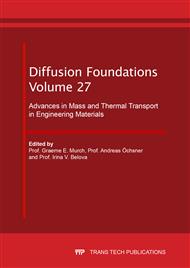[1]
D.R. Dinger, Practical pointers for ceramists, Vol. 1.; C B Dinger, (2010).
Google Scholar
[2]
W.D. Kingery, Factors affecting thermal stress resistance of ceramic materials, J. Am. Ceram. Soc., 38(1) (1955) 3–15.
Google Scholar
[3]
T. Defraeye, Advanced computational modelling for drying process – A review, Appl. Energy, 131 (2014) 323-344.
DOI: 10.1016/j.apenergy.2014.06.027
Google Scholar
[4]
D.A. Brosnan, G. C. Robinson, Introduction to drying of ceramics: With Laboratory Exercises; American Ceramic Society, Westerville, (2003).
Google Scholar
[5]
J.S. Reed, Principles of ceramics processing, second ed., Wiley, New York, (1995).
Google Scholar
[6]
A. Mezquita, J. Boix, E. Monfort, G. Mallol, Energy saving in ceramic tile kilns: Cooling gas heat recovery. Appl. Therm. Eng., 65(1–2) (2014) 102–110.
DOI: 10.1016/j.applthermaleng.2014.01.002
Google Scholar
[7]
T.L. Bergman, F.P. Incropera, D.P. Dewitt, A.S. Lavine, Fundamentals of heat and mass transfer, 7th ed., Wiley, New York, (2011).
Google Scholar
[8]
W.H. Chen, Y.C. Chung, J.L. Liu, Analysis on energy consumption and performance of reheating furnaces in a hot strip mill, Int. Commun. Heat Mass Transf., 32(5) (2005) 695–706.
DOI: 10.1016/j.icheatmasstransfer.2004.10.019
Google Scholar
[9]
B. Hadała, Z. Malinowski, M. Rywotycki, Energy Losses from the Furnace Chamber Walls during Heating and Heat Treatment of Heavy Forgings. Energy, 139 (2017) 298–314.
DOI: 10.1016/j.energy.2017.07.121
Google Scholar
[10]
R.S. Gomez, T.R.N Porto, H.L.F. Magalhães, G. Moreira, A.M. André, R.B.F. Melo, A.G.B. Lima, Natural gas intermittent kiln for the ceramic industry: A transient thermal analysis. Energies, 12(8) (2019) 1568.
DOI: 10.3390/en12081568
Google Scholar
[11]
H.K. Versteeg, W. Malalasekera, An introduction to computational fluid dynamics, The Finite Volume Method, second ed., Pearson Education Limited, Harlow, (2007).
Google Scholar
[12]
S.W. Churchill, H.H.S. Chu, Correlating equations for laminar and turbulent free convection from a vertical plate. Int. J. Heat Mass Transf., 18(11) (1975) 1323–1329.
DOI: 10.1016/0017-9310(75)90243-4
Google Scholar
[13]
I.B. Celik, U. Ghia, P.J. Roache, Procedure for estimation and reporting of uncertainty due to discretization in CFD applications. ASME J. Fluid Eng, 130(7) (2008).
Google Scholar
[14]
M.I. Rodrigues, A.F. Iemma, Experiment design and process optimization, second ed., Cárita Spiritist Editor, Campinas, 2009. (In Portuguese).
Google Scholar


